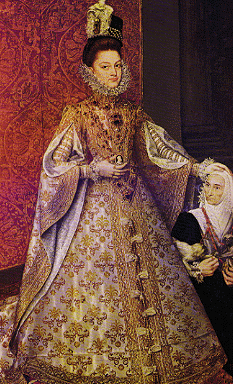
The dress worn by the young Infanta is a wonderful example of Elizabethan Spanish Fashion. The woman in the portrait wears a tight bodice, covering the torso from neck to hips, and a voluminous oversleeve cut open along the front and caught at the wrist to display a striped undersleeve. In fact, the dress as a whole is exceedingly similar to that worn by her stepmother, Anne of Austria, Queen of Spain. . . a similarity which is more than coincidence, certainly. The spanish influence is evident in the high-necked bodice, as well as the sleeves.
This type of sleeve was called a spanish Great-sleeve, and can be found in numerous portraits of Spanish origin. It made its way into english fashion, as well; Queen Elizabeth loved gowns of exotic origin, and had a number made "in the spanysshe fashion". Her wardrobe accounts specify a number of gowns which include Great sleeves, and other portraits of englishwomen also contain this fashionable type of sleeve as the century progresses.
In many of the portraits, the great-sleeve is worn over a close-fitting undersleeve, banded either with bands of embroidery, bands of trim, or bands of pinking and other fabric treatment. In the portrait of The comtesse de guiche and her daughter, both of the women wear similar sleeves to the infanta; the daughter wears the great-sleeves as well.
The servant to the right of the young infanta is dressed in a radically different fashion; her headdress echoes that of the last century. Often, poorer folk would be twenty to thirty years behind the times when it came to fashion; people living in more rural and far-flung areas of England and the continent also wore clothing that was not at all as "cutting edge" as the garb worn for portrait sittings.